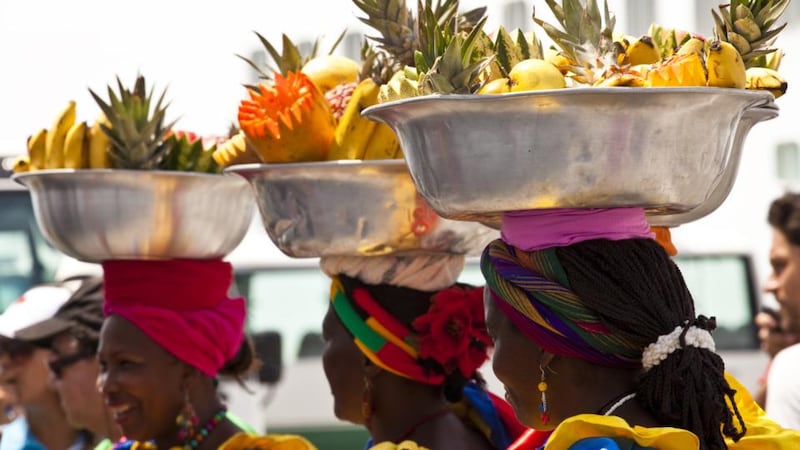It is pronounced Cartahena and this lovely 16th century coastal city in Colombia is as closely associated with Nobel prizewinning author Gabriel García Márquez as Joyce is with Dublin. Marquez memorably portrayed it as a place of "amethyst afternoons and nights of antic breezes", though arriving on a delayed flight from Bogota in a violent thunderstorm, it seemed more like a place of downpours and antic floods, never mind jewelled afternoons.
Known locally as Gabo or Gabito, the writer once said that all of his books have "loose threads" of Cartagena in them. Unlike Dublin, however, where Joyce is part of the tight warp and weft of the city, there are few public connections to Gabo in Cartagena and it was astonishing to discover that neither Of Love and Other Demons nor Love in the Time of Cholera, two of his great literary achievements informed by this city, were to be found in local bookshops.
All that may be changing as this Caribbean city with its narrow, meandering streets enjoys a renaissance as a global tourist destination and is waking up to the potential of Márquez as a visitor draw.

Building restoration of colourful colonial houses with their carved wooden balconies is continuing apace, with new hotels, boutiques and restaurants opening almost weekly within its old stone ramparts.
Thanks to the efforts of local historians a new audio tour called La Cartagena de García Márquez has just been launched, which, for the first time takes the visitor through the city with stories that identify places and people behind his works and his experience living there.
I took the tour – they give you a headset and a headstart, but you’re on your own – which has 35 stops, mine beginning at his house facing the sea.
In Love in the Time of Cholera, the novel based on the love affair of Márquez's parents, it is the fictional home of Fermina Diaz with whom Florentino is besotted.
In reality it is where the 85-year-old writer who lives in Mexico often stays in winter, occasionally dropping in to the El Coro bar next door in the Sofitel Santa Clara hotel for a drink. The hotel, a converted 17th century convent, houses a crypt below the bar where in the 1940s, Marquez, then working as a journalist, was sent to investigate a report that the remains of a 12-year-old girl with 70 feet of copper hair had been found there.
That incident formed the basis of his novella Of Love and Other Demons. Free copies are now left in the bedrooms of the hotel which attracts high profile guests and upmarket weddings, but in another life housed nuns who said goodbye to the outside world once they crossed the threshold.
As chaste postulants, apart from their religious duties, they were known to enjoy smoking, “inhaling thick cigars and introducing the part that was lit into their mouths” according to a local history.
Today the hotel’s residents include a toucan called Mateo and tiny musical frogs whose surrealist serenades can be heard at night in the courtyard’s lush vegetation.
Nearby, back on the tour, one of the more memorable stops is the home of the painter Alejandro Obregon who lived and worked on Calle de la Factoria from 1970 until his death in 1992.
He was a great friend of Márquez and the story is told of how one night, in a drunken fit, the painter took up a gun and fired it at his self portrait, hitting it straight in the eye. This was then given to Márquez as a gift, but the next morning, the painter asked for it back – it was later restored in Mexico.
Other stops included the former offices of where Márquez worked as a newspaper reporter and the Casa Roman building, fictional site of the apothecary in Love in the Time of Cholera.
In Plaza Fernandez de Madrid, there are places to sit where Florentino lingered in the shade of the almond trees hoping to catch a glimpse of Fermina (well captured in the 2007 movie with Javier Bardem) and there is Plaza de las Coches where the rabid dog bit the beautiful and rebellious Sierva Maria in Of Love and other Demons.
Apart from the audio tour, a good local guide printed in both Spanish and English that I found is Cartagena Lure which has insider information, itineraries and a list of the best the city has to offer.
It directed me for a coffee to Juan Valdez, a national chain, in the square of the university where Márquez studied and where a smart new hotel called Casa San Augustin has just opened. Nearby there's a handsome shop called Ketty Tinoco selling the classic guayabera white shirts and Caribbean-inspired embroidered blouses in Irish linen. The Cartagena-born owner is known as "La Dama del Lino" and a new book about her designs is shortly to be translated into English from Spanish.
Incidentally, Márquez was a keen reader of fashion magazines “all kinds of magazines for women and gossip magazines”, he once said in an interview. “And I learnt many things that I could only learn from reading them – that keeps me very busy”, he added, which might explain his perceptive and sensuous descriptions of dress and undress in his novels.
Today in the city, the fruit basket women, descendants of free slaves called palenqueras vibrantly decked out in Carmen Miranda skirts are a huge tourist draw, not to speak of their tempting fare – juicy pineapples, mangoes and melons.
Among the other highlights, a day trip to the Rosario islands is rewarding, but for Márquez pilgrims the guided city tour, more than two hours long and choc a bloc with information, is a great way to while away a morning – or an amethyst afternoon – in this beguiling multi-cultural city. But bring comfortable walking shoes.

















